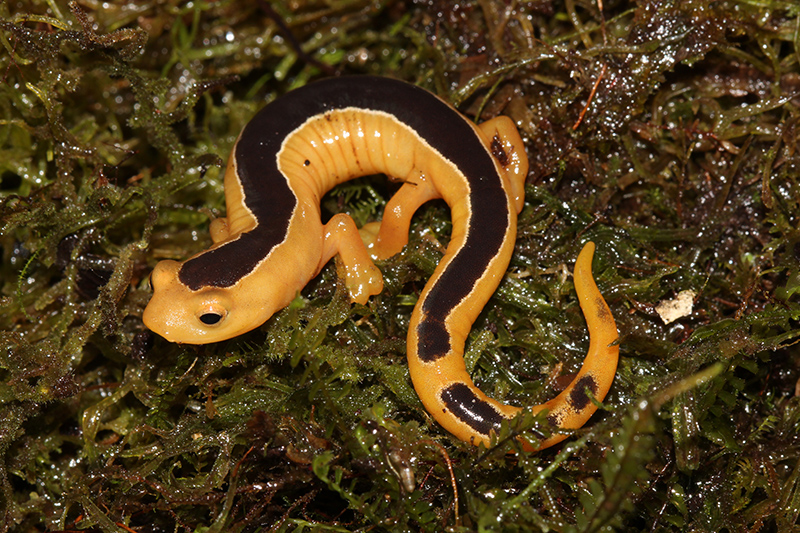Bolitoglossa jacksoni, the lost ‘Golden Wonder’ salamander. Image: Carlos Vasquez Almazan
By Nina Seale, Engagement Assistant, Synchronicity Earth
Synchronicity Earth is proud to announce a new partner for our rapidly developing Amphibian Programme: Foundation for Ecodevelopment and Conservation (FUNDAECO) in Guatemala. FUNDAECO, also an Amphibian Survival Alliance Partner, is an extraordinary organisation, with projects ranging from female empowerment in mountain communities to large-scale carbon storage, but it was their work with amphibians which really caught our attention.
In October 2017, Tomás Ramos León was patrolling the edge of the Yal Unin Yul Witz Protected Nature Reserve when he saw something that had not been witnessed by human eyes for over 40 years.
A shift as a reserve guard in Western Guatemala is no walk in the park. With steep climbs, muddy slopes and frequent heavy rain, it is a heavy-duty hike. But Tomás was motivated by a decades long mystery which had haunted these mountains for years: the disappearance of the ‘golden wonder’.
The golden wonder is one of the many names of the Jackson’s Climbing Salamander or Bolitoglossa jacksoni, about which Tomás had learned during a workshop held by one of Guatemala’s leading amphibian experts: Carlos Roberto Vásquez Almazán. Carlos had visited the guards of Yal Unin Yul Witz and taught them about the rare and elusive amphibians of their unique reserve, including how to identify one which hadn’t been seen for four decades. The golden wonder was discovered in the Western Highlands of Guatemala in 1975 and promptly disappeared. There had been no recorded sightings since.
Like the other guards, Tomás comes from the local community adjacent to the reserve, Santo Domingo Chiblac, and he belongs to the Mayan ethnic group Q´anjob´al. He had always been keen to discover the secrets of the reserve, using his patrols to look in the damp and dark hidey holes where Guatemala’s unseen treasures lurk: under logs, rocks, and roots. So when he heard about the golden wonder, he wanted to be the one to rediscover it.
“I had always dreamed about finding this salamander,” Tomás said. “I have found rare salamanders, frogs, toads and snakes before, but this was very different because it was believed to be extinct – it is of interest to the world.”
And then one day, there it was. Underneath some leaf litter, the striking black and yellow colours of the unmistakable Jackson’s Climbing Salamander.
“I had no doubts that it was the Bolitoglossa jacksoni, recognising its striking colours instantly.” He photographed it and sent the photos via WhatsApp to Carlos, who excitedly confirmed that he had rediscovered a lost species.
Sleeping Child Between Mountains
Yal Unin Yul Witz is the name of the reserve in the Mayan language Q’anjob’al. It translates to ‘Sleeping Child Between Mountains’, which refers to the salamanders themselves, who are described by several indigenous communities as the sleeping children in the forests.
The golden wonder is only one of the many rare and beautiful amphibian species in these mountains. At the same time the Jackson’s Climbing Salamander was discovered, so was the Finca Chiblac Salamander and Nimble Long-limbed Salamander, both of which are rare and endangered. There are also healthy populations of rare frogs, including Critically Endangered Perkins’ Treefrog and Ixil Spikethumb Frog.
This is one of the reasons why Foundation for Ecodevelopment and Conservation (FUNDAECO), an accomplished conservation charity in Guatemala, purchased the land (then known as Finca San Isidro) to create a protected reserve for amphibians in 2015 with the help of several international partners (International Conservation Fund of Canada, World Land Trust, Global Wildlife Conservation/Amphibian Survival Alliance and Rainforest Trust). These reserves are managed together with the local indigenous communities, who take the lead in protecting them.
The guardians of the forest
Creating reserves to protect important amphibian habitats like Yal Unin Yul Witz in the Western Highlands and La Firmeza Amphibian Reserve (in the Sierra Caral, on the eastern border with Honduras) is just one branch of FUNDAECO’s amphibian conservation work.
One of the key hurdles to effective amphibian conservation is lack of knowledge. Without research identifying the species and habitats which should be our priority to conserve, it is much harder to know which areas need urgent action.
This is why the people around FUNDAECO’s reserves, like Tomás Ramos León, are receiving training in amphibian identification – they are the ones on the ground who, as well as protecting the reserve itself, can gather invaluable insights into the wildlife they are protecting. Their findings will also be used to help create environment education programmes to engage local communities, teaching them about their local wildlife and involving them in its protection.
Stepping up
Amphibian conservation is one of the overlooked and underfunded conservation challenges that our research has identified, which is why we founded our Amphibian Programme. So far the programme has concentrated on assessing amphibians for the IUCN Red List of Threatened Species, which is used globally to highlight priority species, and identifying key areas for amphibians which need to be protected through the Amphibian Survival Alliance.
But now, in addition to this important work, we are expanding to support amphibian conservation in the field. Simon Stuart, Synchronicity Earth’s Director of Conservation, says “FUNDAECO’s work in their amphibian reserves addresses two of the key priorities for amphibian conservation: protecting habitats on the ground and improving the knowledge base which will inform further conservation efforts. This is why we are proud to announce our new partnership with them as our Amphibian Programme develops.”

